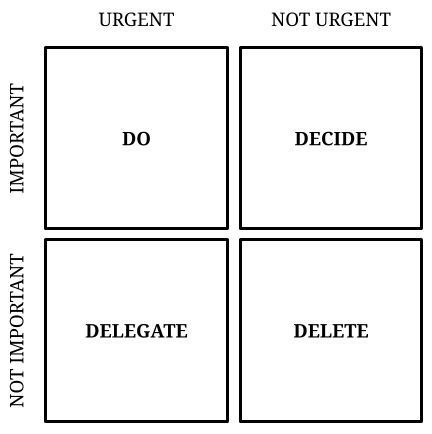Understanding Urgency and Importance: A Guide to Prioritization
Written on
Chapter 1: The Eisenhower Method Explained
The Eisenhower Method, commonly recognized through its quadrant framework, serves as a valuable tool for addressing one of the modern world's most challenging dilemmas: how to prioritize tasks and focus our attention effectively. This approach is named after the 34th President of the United States, Dwight D. Eisenhower, who famously stated that problems can be classified as urgent or important, but not both simultaneously. Yet, the method delves deeper than this binary classification; it acknowledges that tasks can be important but not urgent, urgent but not important, or even both urgent and important. Additionally, it introduces a fourth category for tasks that are neither urgent nor important, which often don’t pose genuine problems.
For instance, when I consider tasks that are important but not urgent, I think of planning. Preparing for a studio session by setting up microphones and instruments in advance ensures a smooth recording process. Conversely, when I neglect this planning, it transforms into an urgent task, creating unnecessary pressure as musicians await my setup. Planning for yearly goals may not seem urgent, yet it helps prevent last-minute chaos as December approaches. Similarly, exercising today may not feel urgent; skipping a workout won’t drastically affect my fitness, but neglecting it over time could lead to negative consequences. Thus, while today’s exercise is important, it isn’t urgent.
Tasks that are both urgent and important are often glaringly obvious: crises, service interruptions, or missed deadlines demand immediate attention. Ironically, these situations often arise from neglecting important but non-urgent tasks. Having been part of teams that operate under constant stress, I can attest to the unpleasantness of such environments. Anyone who has faced the daily uncertainty of a workplace crisis understands the toll it takes on mental well-being. I excelled at crisis resolution but took too long to realize the importance of preventing such crises in the first place.
While the Eisenhower Method can effectively prompt us to reflect on our tasks, the real challenge lies in accurately categorizing them. Understanding how a task can be urgent yet unimportant took time for me to grasp. Such tasks are pervasive: annoying phone calls, unsolicited messages, incessant notifications, and trivial conversations all vie for our attention. Our devices, constantly buzzing for our focus, and distractions from colleagues or entertainment can easily pull us away from what truly matters.
Finally, we encounter tasks that fall into the category of neither important nor urgent. These are the tasks I argue aren’t problems at all. If something isn’t urgent or important, it can be eliminated from our to-do lists. However, engaging in seemingly trivial activities—like reading for pleasure, playing games, or enjoying casual outings—can provide us with much-needed relaxation and perspective.
This is the moment we can confront the four categories of tasks: discerning what is urgent, what is important, what is both, and what is neither. It is during these calm moments of clarity that we can prioritize effectively, free from stress and haste.
The Eisenhower Method itself is straightforward, yet the complexity arises from our mental state when we apply it.
PS: A shoutout to Frank Font for inspiring this discussion!
Today's level of optimistic pessimism: 70%.
Thank you for your support as I embark on this journey! Your encouragement means a lot.
Who am I, you might wonder? I’m a musician and writer, weaving together my passions. Discover more about my world here.
Section 1.1: The Eisenhower Matrix
The Eisenhower Matrix is a powerful framework that helps individuals prioritize their tasks based on urgency and importance. This is especially pertinent in today's fast-paced environment where distractions abound.

In this video, "The Eisenhower Matrix (aka Urgent Important Matrix / Time Management Matrix) - RATED!!!", you'll discover how this tool can enhance your time management skills and help you prioritize effectively.
Section 1.2: The Dangers of Urgency
Understanding the consequences of prioritizing urgent but unimportant tasks is crucial to maintaining productivity.
The podcast "Is the Urgent/NOT Important Quadrant Killing Productivity?" explores how these distractions can hinder your effectiveness and offers strategies for overcoming them.
Chapter 2: Implementing the Method
This chapter focuses on practical steps to effectively implement the Eisenhower Method in your daily life. Learn how to distinguish between different task categories and create a more balanced approach to productivity.